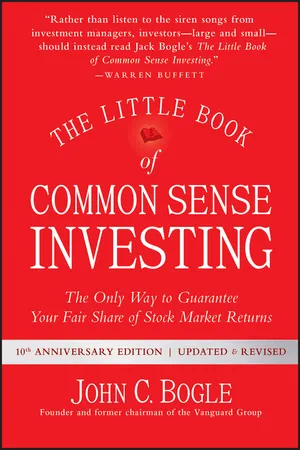
The Little Book of Common Sense Investing
The Only Way to Guarantee Your Fair Share of Stock Market Returns
- English
- ePUB (mobile friendly)
- Available on iOS & Android
The Little Book of Common Sense Investing
The Only Way to Guarantee Your Fair Share of Stock Market Returns
About this book
The best-selling investing "bible" offers new information, new insights, and new perspectives
The Little Book of Common Sense Investing is the classic guide to getting smart about the market. Legendary mutual fund pioneer John C. Bogle reveals his key to getting more out of investing: low-cost index funds. Bogle describes the simplest and most effective investment strategy for building wealth over the long term: buy and hold, at very low cost, a mutual fund that tracks a broad stock market Index such as the S&P 500.
While the stock market has tumbled and then soared since the first edition of Little Book of Common Sense was published in April 2007, Bogle's investment principles have endured and served investors well. This tenth anniversary edition includes updated data and new information but maintains the same long-term perspective as in its predecessor.
Bogle has also added two new chapters designed to provide further guidance to investors: one on asset allocation, the other on retirement investing.
A portfolio focused on index funds is the only investment that effectively guarantees your fair share of stock market returns. This strategy is favored by Warren Buffett, who said this about Bogle: "If a statue is ever erected to honor the person who has done the most for American investors, the hands-down choice should be Jack Bogle. For decades, Jack has urged investors to invest in ultra-low-cost index funds.... Today, however, he has the satisfaction of knowing that he helped millions of investors realize far better returns on their savings than they otherwise would have earned. He is a hero to them and to me."
Bogle shows you how to make index investing work for you and help you achieve your financial goals, and finds support from some of the world's best financial minds: not only Warren Buffett, but Benjamin Graham, Paul Samuelson, Burton Malkiel, Yale's David Swensen, Cliff Asness of AQR, and many others.
This new edition of The Little Book of Common Sense Investing offers you the same solid strategy as its predecessor for building your financial future.
- Build a broadly diversified, low-cost portfolio without the risks of individual stocks, manager selection, or sector rotation.
- Forget the fads and marketing hype, and focus on what works in the real world.
- Understand that stock returns are generated by three sources (dividend yield, earnings growth, and change in market valuation) in order to establish rational expectations for stock returns over the coming decade.
- Recognize that in the long run, business reality trumps market expectations.
- Learn how to harness the magic of compounding returns while avoiding the tyranny of compounding costs.
While index investing allows you to sit back and let the market do the work for you, too many investors trade frantically, turning a winner's game into a loser's game. The Little Book of Common Sense Investing is a solid guidebook to your financial future.
Frequently asked questions
- Essential is ideal for learners and professionals who enjoy exploring a wide range of subjects. Access the Essential Library with 800,000+ trusted titles and best-sellers across business, personal growth, and the humanities. Includes unlimited reading time and Standard Read Aloud voice.
- Complete: Perfect for advanced learners and researchers needing full, unrestricted access. Unlock 1.4M+ books across hundreds of subjects, including academic and specialized titles. The Complete Plan also includes advanced features like Premium Read Aloud and Research Assistant.
Please note we cannot support devices running on iOS 13 and Android 7 or earlier. Learn more about using the app.
Information
Chapter One
A Parable: The Gotrocks Family
Once upon a Time . . .
Get rid of all your Helpers. Then your family will again reap 100 percent of the pie that corporate America bakes for you.
. . . and the Gotrocks Family Lived Happily Ever After
Don’t Take My Word for It
Note
Chapter Two
Rational Exuberance:...
Table of contents
- Cover
- Table of Contents
- Introduction to the 10th Anniversary Edition
- Chapter One: A Parable
- Chapter Two: Rational Exuberance
- Chapter Three: Cast Your Lot with Business
- Chapter Four: How Most Investors Turn a Winner’s Game into a Loser’s Game
- Chapter Five: Focus on the Lowest- Cost Funds
- Chapter Six: Dividends Are the Investor’s (Best?) Friend
- Chapter Seven: The Grand Illusion
- Chapter Eight: Taxes Are Costs, Too
- Chapter Nine: When the Good Times No Longer Roll
- Chapter Ten: Selecting Long-Term Winners
- Chapter Eleven: “Reversion to the Mean”
- Chapter Twelve: Seeking Advice to Select Funds?
- Chapter Thirteen: Profit from the Majesty of Simplicity and Parsimony
- Chapter Fourteen: Bond Funds
- Chapter Fifteen: The Exchange-Traded Fund (ETF)
- Chapter Sixteen: Index Funds That Promise to Beat the Market
- Chapter Seventeen: What Would Benjamin Graham Have Thought about Indexing?
- Chapter Eighteen: Asset Allocation I: Stocks and Bonds
- Chapter Nineteen: Asset Allocation II
- Chapter Twenty: Investment Advice That Meets the Test of Time
- Acknowledgments
- End User License Agreement